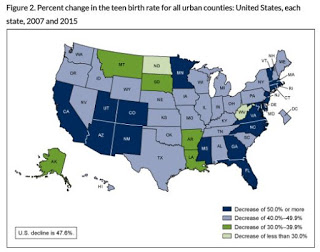Teen birth rates are declining faster in urban counties than rural ones, nationally and in Kentucky

Kentucky Health News
Kentucky’s teen birth rates are dropping faster in its urban counties than in its rural counties, a trend that has also been found across the nation, according to the federal Centers for Disease Control and Prevention.
A CDC report looked at the differences between teen birth rates in rural and urban areas from 2007 to 2015 and found that among teens ages 15 to 19, birth rates in Kentucky’s urban counties dropped 43.9 percent, and 31.8 percent in its rural counties. Both lagged the national decreases; teen births in the U.S. dropped 47.6 percent in urban counties and 37.1 percent in rural ones during the period.
In Kentucky, the teen birth rate in urban counties was 26.4 births per 1,000 females in 2015, a reduction of 44 percent from the 47.1 reported in 2007. The state’s rural teen birth rate was 40.9 per 1,000 in 2015, a 33 percent reduction from the 60 per 1,000 in 2007.
While teen birth rates have dropped significantly in Kentucky in recent years, they remain higher than the national average. Kentucky’s teen birth rate in 2015 was 32.4 per 1,000, almost half again as much as the national average of 22.3 per 1,000.
Nationally, in large urban counties teen birth rates fell 50 percent between 2007 and 2015, 18.9 births per 1,000. The rate dropped 44 percent in small to medium-sized urban counties, to 24.3 births per 1,000; and 37 percent in rural counties, from 49.1 to 30.0 per 1,000.

The report didn’t explain why teen birth rates have decreased more in urban areas, but in 2015 the National Campaign to Prevent Teen and Unplanned Pregnancy issued a report that tried to explain the disparities, Sarah Frostenson reports for Vox.
It found that teens in rural areas have reduced access to health services that offer contraception, have fewer college opportunities, have higher uninsured rates, have higher poverty rates and have fewer “positive recreational outlets,” which is associated with increased risk taking.
“Disparities in the teen birth rate, which we believe mirror disparities in the teen pregnancy rate, are largely explained by differences in economic opportunities and access to health care, including access to contraceptive services,” says the report.
In Kentucky, teens in rural counties have access to contraception at local health departments, which can provide a broad range of contraceptive choices to teens without parental consent. However, the National Campaign report found that rural teens often face transportation barriers.
“All adolescents receiving family planning services in the local health department receive counseling on family involvement in decision making (regardless if a parent is present or not), avoiding sexual coercion and abstinence as the healthiest contraceptive choice for teens,” according to an e-mail from the Department for Public Health‘s Division of Women’s Health.
Another challenge facing Kentucky teens is a possible lack of reliable information about sex because the state only requires abstinence be taught in the classroom during mandated sex education classes (an approach that has been proven ineffective) and doesn’t require a set curriculum for fact-based, comprehensive sex education.
The CDC report also showed disparities by race and geographic location.
It found that in 2015, birth rates among white teens was lowest in large urban counties, but about 2.5 times higher in rural counties than in large urban ones (10.5 and 26.8 per 1,000 respectively). It found that teen birth rates among Hispanic teens (34.1 per 1,000) and black teens (29.1 per 1,000) were higher than the white teen rate and that birth rates for both of these groups were even higher in rural counties, 39.6 per 1,000 births for black teens and 47 per 1,000 for Hispanic teens.
